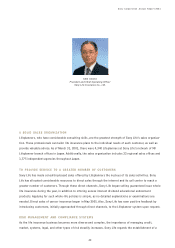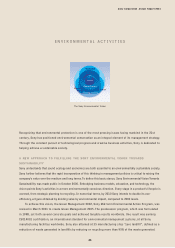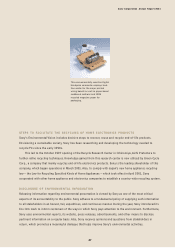Sony 2001 Annual Report Download - page 48
Download and view the complete annual report
Please find page 48 of the 2001 Sony annual report below. You can navigate through the pages in the report by either clicking on the pages listed below, or by using the keyword search tool below to find specific information within the annual report.
Sony Corporation Annual Report 2001
46
Sony Corporation Annual Report 2001
46
Green Management 2005 goes further still, outlining an action plan to fulfill the Environmental Vision’s
intermediate target of achieving 1.5 times eco-efficiency by 2005. Many numerical goals are listed to raise
the environmental perspective of a broad range of activities, including R&D, product design, procurement
and purchasing, site management and production processing, marketing, distribution, repair services,
customer services, and even information disclosure programs.
ADDING THE ENVIRONMENT TO PERFORMANCE CRITERIA AT NETWORK COMPANIES
Beginning with the year under review, Sony added the “Environment” category to the criteria used to evaluate
each internal Network Company’s performance. With this step, environmental programs were solidly positioned
as a core element of management policies. In evaluating Network Companies, environmental criteria account
for about 10% of the total assessment. The focus of such evaluations is to determine the amount by which Sony
Network Companies actually reduced their impact on the environment during the year.
MANAGEMENT OF ENVIRONMENTAL RISK AND EMPLOYEE HEALTH AND SAFETY FOR
BUSINESS AND PRODUCTION PROCESSES
Along with lowering the environmental impact of business facilities, Sony Environmental Vision stresses two
important areas: environmental risk management and employee health and safety management. During the
year, 35 non-manufacturing facilities, such as that of Sony Computer Entertainment Inc. obtained ISO14001
certification. Additionally, 19 manufacturing facilities, such as Sony Chemicals Singapore Pte. Ltd., met the
OHSMS (Occupational Health and Safety Management System) standard, an international standard for systems
used to manage employee health and safety.
AIMING FOR “ZERO LANDFILL” AT BUSINESS FACILITIES
Along with energy conservation and the management and reduction of chemical substances used, Sony
strives for the control, sorting, reuse, and recycling of waste materials at business facilities. Green Manage-
ment 2005 challenges all Sony business facilities to achieve “zero landfill” by the year 2005. 35 manufactur-
ing facilities, including Beijing Suohong Electronics Co., Ltd. and Gödölö Factory in Hungary, had already
achieved the “zero landfill” goal, by the end of April 2001.
PROMOTING ENVIRONMENTALLY SOUND PRODUCTS
Sony lightens the environmental impact of its products by making products that require fewer resources,
consume less energy, and reduce or eliminate materials that significantly impact the environment.
For example, a Sony Digital Handycam camcorder that went on sale in March 2001 employs lead-free
solder for the major printed wiring boards, and resins in the main circuit boards and camera body contain no
halogenated flame retardants. Additionally, there is no PVC (Polyvinyl Chloride) in any internal or external
structural components other than wiring materials. The viewfinder’s LCD is backlit by LEDs rather than a
fluorescent lamp, eliminating the use of mercury. Packaging materials feature cardboard cushions and paper,
both made entirely of recycled content. Moreover, the color printing on the product’s cardboard packaging
uses vegetable oil-based printing ink which is free of VOCs (Volatile Organic Compounds).
























